Girls' Village Home, Barkingside, Ilford, Essex
Following the failure of his first girls' home at Mossford Lodge, Barkingside, Thomas Barnardo decided to try a different approach. Mossford Lodge, like most children's homes of the day, had been what was often referred to as a 'barrack home'. Such institutions, where large numbers of children were herded together, were increasingly seen by critics as injurious to the physical, educational and social development of their inmates, especially girls. An alternative style of institution, originating in Europe but starting to create interest in Britain, was based on the 'cottage homes' model, with children living in small family-style groups under the supervision of a house-mother.
At the time, only two cottage homes institutions existed in England: the Home for Little Boys at Farningham in Kent opened in 1865, and Princess Mary's Village Home for Little Girls at Addlestone in Surrey founded in 1870. Barnardo decided to follow a similar route and announced plans for a girls' village home at Barkingside on land adjoining Mossford Lodge. He claimed that the idea had come to him in a dream but it is likely that he was aware of at least the Addlestone development.
Barnardo's appeal for funds for his new scheme initially generated little response but received a boost when a Mr Dawson offered to finance the first cottage in memory of a much-loved daughter who had died. Within six months, money had been pledged for a further ten cottages and the ceremonial laying of their foundation stones took place in 1875. The official opening of the first thirteen cottages was carried out on July 9th, 1876.
Development of the village occurred in three main phases. The original group of cottages running parallel with Horns Road at the eastern edge of the site were constructed in 1876-79. A second group, built in 1887-89 around what became known as the Babies' Green, ran westwards of the Horns Road entrance. The final group, erected in 1903-06, stood around a large green to the west of the original group. Providing an access route from the entrance through to this third section necessitated demolition of three of the original cottages at the south side of Cairns House. Two of these, Beehive and Eton, had their names transferred to new phase three cottages. The name of the third cottage, Hahnemann, appears not to have been retained. The size of the cottages changed in each phase of development. The initial group each generally housed sixteen girls, the second group twenty-five, and the third group twenty. The final capacity of the home was around 1500 girls (plus a few small boys).
The layout of the home in the mid-1930s is shown on the map below.
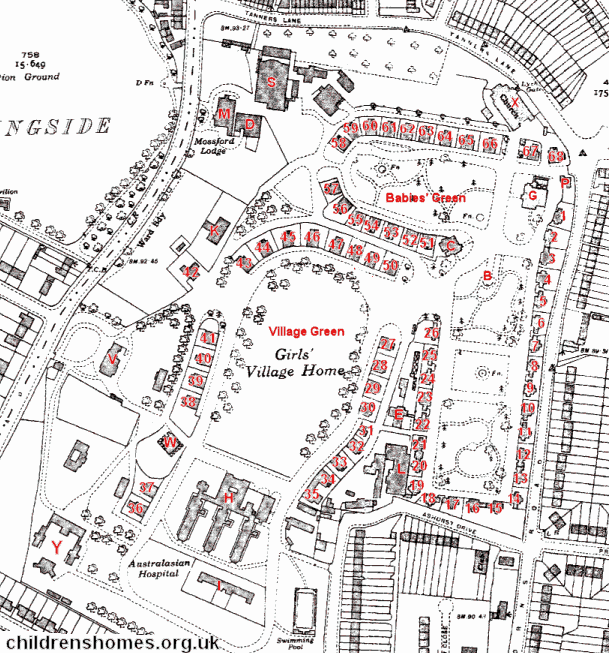
Girls' Village Home site, Barkingside, c.1938.
A list of the cottages and other (with their date of construction) is given in the table below. The number or letter in front of each name is used to mark its position on the map above.
|
1. Armitie (1904) 2. Halifax (1878) 3. Babies [later Gordon] (1878) 4. Heather (1879) 5. Woodbine (1876) 6. Craven (1878) 7. Salem (1878) 8. Clapham (1876) 9. Cambridge (1876) 10. Daisy (1876) 11. Forget-me-not (1876) 12. Honeysuckle (1876) 13. Hawthorn [later Honeythorne] (1876) 14. Jessamine (1876) 15. Billiter (1876) 16. Trefoil (1878) 17. Heartsease (1878) 18. Rose (1876) 19. Primrose (1876) 20. Wild Thyme (1878) 21. Violet (1878) 22. Bath (1878) 23. Lilly (1876) 24. Clarellen (1879) 25. May (1879) 26. Myrtle (1876) 27. Hyacinth (1879) 28. Ethel Bolton (1903) |
29. Faith (1903) 30. Dr Truell (1903) 31. Dorothy (1911) 32. Larchfield McCulloch (1905) 33. Joy (1905) 34. Benjamin Hood (1905) 35. Eleanor Hood (1909) 36. James Holmes Lucking (1906) 37. Young Helpers League (1906) 38. Francis Reckitt (1904) 39. Sir George Williams (1904) 40. Crosswell (1904) 41. John Howard Angas (1904) 42. Meadow (?) 43. Marian (1904) 44. Henry Mountain (1904) 45. Gustasp (1904) 46. Cannizaro (1903) 47. John Sands (1903) 48. Mignonette (1903) 49. Beehive (1879) 50. Eton (1879) 51. Clement (1887) 52. Mayflower (1887) 53. Cyril (1887) 54. Sir James Tyler (1887) 55. Ilex (1887) 56. Hope (1887) |
57. Peace (1887) 58. Burwell Park (1887) 59. Curling (1887) 60. Mickleham (1887) 61. Sweet Briar (1887) 62. Pink Clover (1887) 63. Ivy (1887) 64. Oxford (1887) 65. St Helena (1887) 66. Syndal (1887) 67. Pussy (1887) 68. Joicey (1887) B. Dr Barnardo's Grave C. Cairns House (1887) D. Dressmaking & Cookery School (1896) E. Embroidery School (1903) G. Governor's House (1876) H. Australasian Hospital (1911) I. Isolation Hospital K. Library L. Laundry (1876) M. Mossford Lodge (1870) P. Porter's Lodge (1876) S. Schools (1896) V. Queen Victoria House W. Watts Sanatorium (1904) Y. Cherry Court |
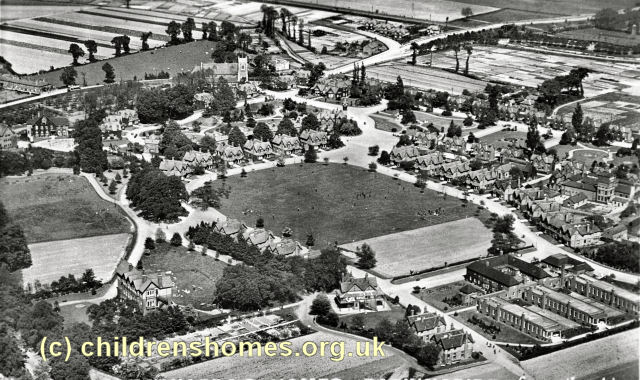
Girls' Village Home aerial view from the south-west, date unknown. © Peter Higginbotham
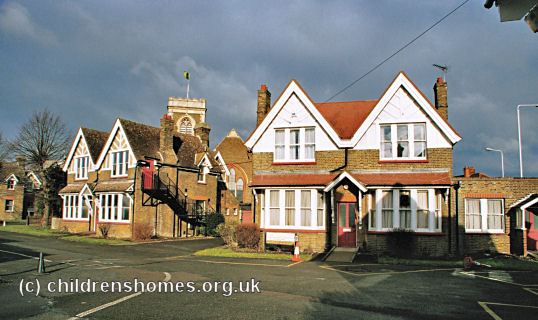
Girls' Village Home — Pussy and Joicey cottages, 2005. © Peter Higginbotham
At one time, Meadow Cottage was used only to house babies.
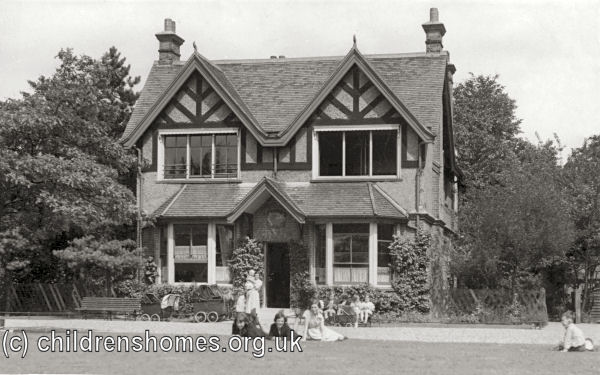
Girls' Village Home cottage, early 1900s. © Peter Higginbotham
Queen Victoria House was originally used as a receiving and quarantine house for new arrivals at the Village Home but in 1928 became a training home for girls who were being emigrated to Canada or Australia.
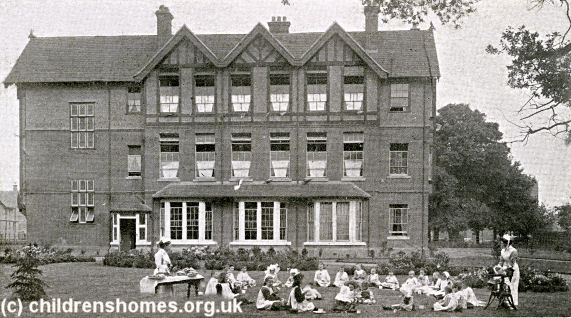
Girls' Village Home — Queen Victoria House, no date. © Peter Higginbotham
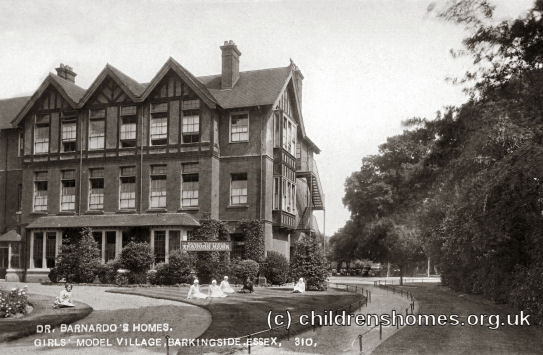
Girls' Village Home — Queen Victoria House, no date. © Peter Higginbotham
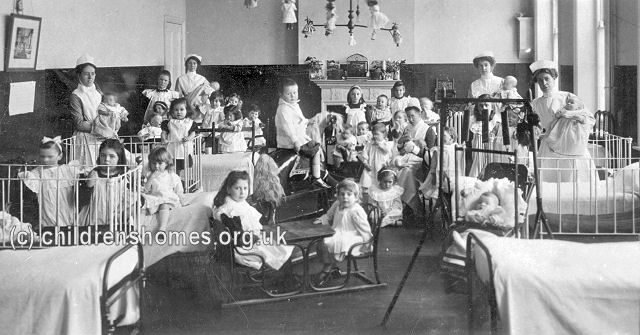
Girls' Village Home — Queen Victoria House, 1914. © Peter Higginbotham
The Watts Sanatorium provided facilities for the treatment of cases of tuberculosis, a condition then found particularly amongst those who had been living in poor conditions. The building was later used to house the Village Home's babies.
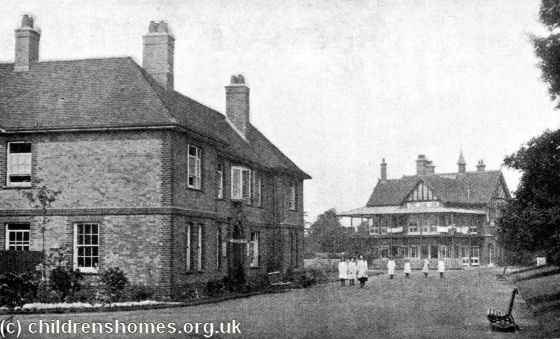
Girls' Village Home — Hospital central block (left) and Watts Sanatorium, c.1914. © Peter Higginbotham
In 1901-11, a new hospital facility was erected at the south of the site. It was funded by gifts collected in Australia and New Zealand and so was named the Australasian Hospital.
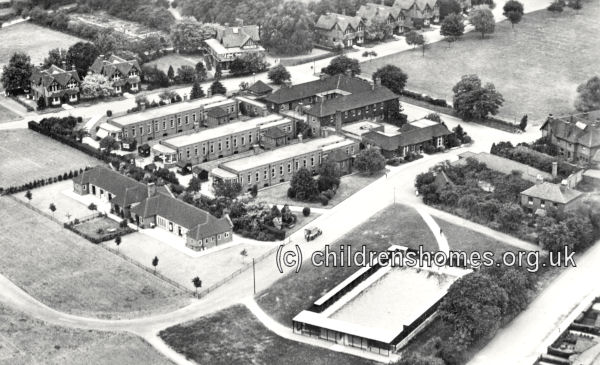
Girls' Village Home — Australasian Hospital aerial view from the south-east. © Peter Higginbotham
The Cairns Memorial House was erected in memory of the first President of the Dr Barnardo's Homes, Earl Cairns, and was opened on 6th August 1887.
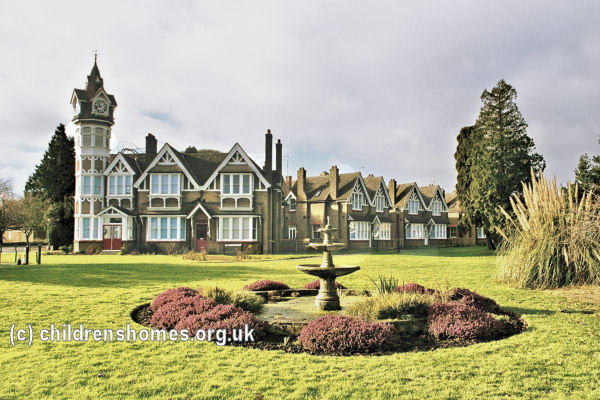
Girls' Village Home — Cairns House (left), 2005. © Peter Higginbotham
Mossford Lodge and the Australasian Hospital are described on separate pages.
The main future destination for girls at Barkingside were entry into domestic service or emigration to Canada and Australia — in the early 1900s, around 300 a year departed for Canada. As well as basic education, the girls were trained in skill such as baking and bread-making, washing and laundry work, dressmaking, knitting, needlework and embroidery, crochet and lace-making.

Girls' Village Home embroidery school, no date. © Peter Higginbotham
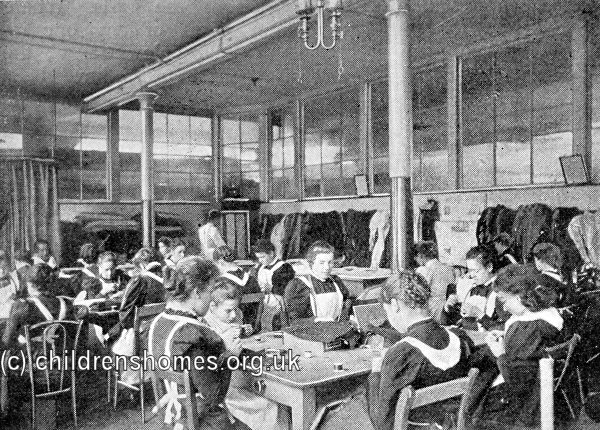
Girls' Village Home — dressmaking class, c.1906. © Peter Higginbotham
The home's steam laundry carried out the washing of clothes, bed-linen etc. for the whole home. In 1912, the total number of articles processed was reckoned to be 1,091,961.
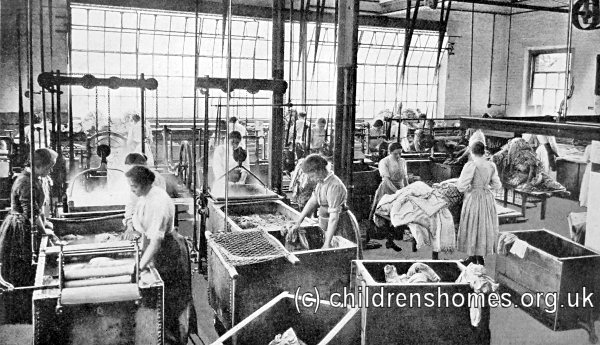
Girls' Village Home — the laundry, c.1906. © Peter Higginbotham

Girls' Village Home ironing room, no date. © Peter Higginbotham
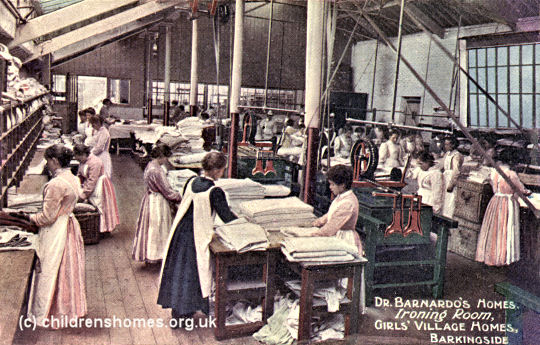
Girls' Village Home ironing room, no date. © Peter Higginbotham
As well and education and training, the home placed a great emphasis on physical fitness. A swimming pool was constructed at the south of the site (see Hospital photo above). The girls also performed activities such as musical drill.

Girls' Village Home musical drill, no date. © Peter Higginbotham

Girls' Village Home school (left), no date. © Peter Higginbotham
Thomas Barnardo died on September 19th, 1905, with his funeral taking place eight days later in a large marquee at the Girls' Village. On October 4th, his now cremated remains were placed in a grave in front of Cairns House. A view (below) from the church tower, presumably taken on the day of his funeral, marks the location of the grave with a white cross. A stone monument was erected over the grave in 1908.

Girls' Village Home view from tower, date unknown. © Peter Higginbotham
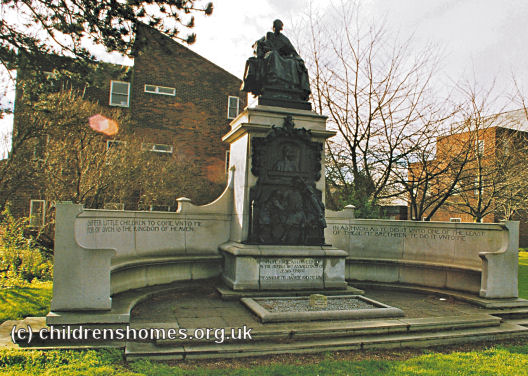
Girls' Village Home — Barnardo's grave, 2005. © Peter Higginbotham

Girls' Village Home — Barnardo's grave, 2005. © Peter Higginbotham
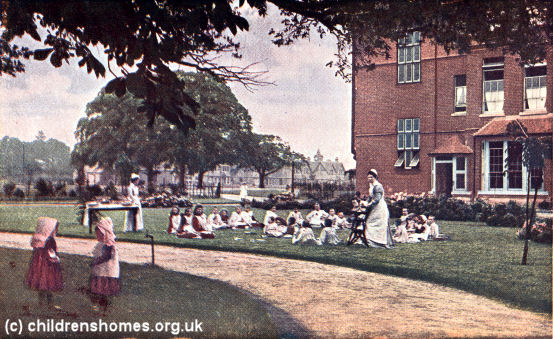
Girls' Village Home — tea on the lawn, no date. © Peter Higginbotham

Girls' Village Home — ornamental gardens, no date. © Peter Higginbotham
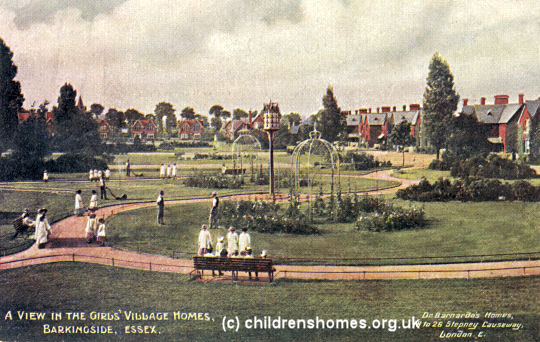
Girls' Village Home — ornamental gardens, no date. © Peter Higginbotham
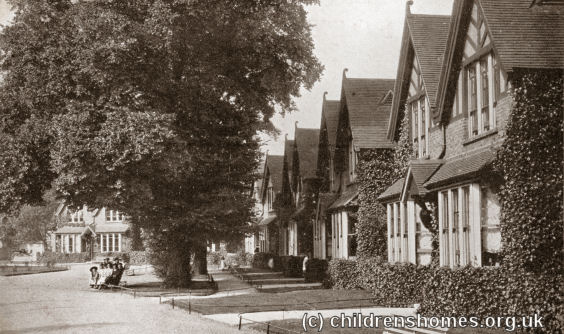
Girls' Village Home, no date. © Peter Higginbotham
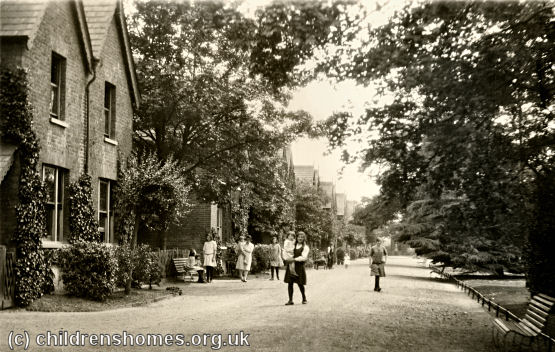
Girls' Village Home, no date. © Peter Higginbotham

Girls' Village Home, no date. © Peter Higginbotham

Girls' Village Home — open day display, no date. © Peter Higginbotham
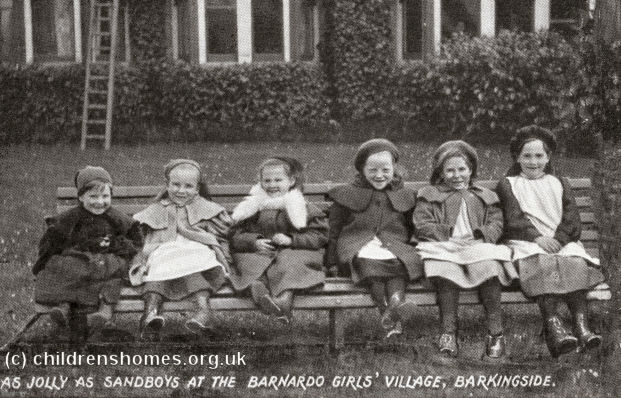
Girls' Village Home, no date. © Peter Higginbotham
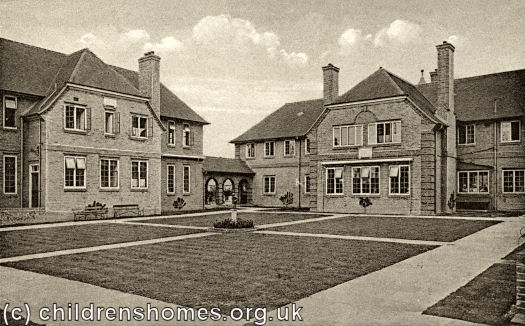
Girls' Village Home — Cherry Court, 1930s. © Peter Higginbotham
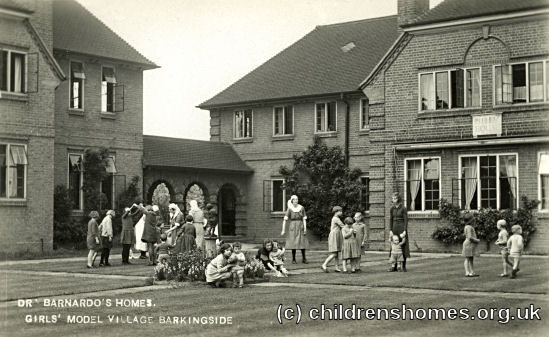
Girls' Village Home — Cherry Court, 1930s. © Peter Higginbotham
As well as the accommodation in the Village Home itself, a number hostels were later established in the area for girls from the home who had moved into service. These included Frostmead, Tudor House and Southwood House.
In 1936, the girls received a piece of Princess Elizabeth's 10th birthday cake (picture below). It must have been an enormous cake!
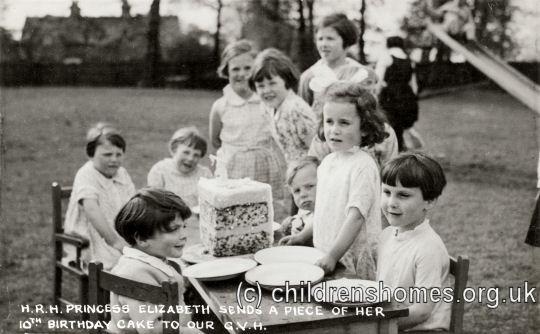
Girls' Village Home. Barkingside, 1936. © Peter Higginbotham
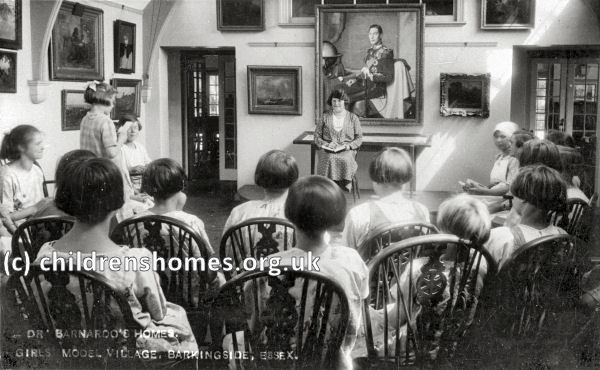
Girls' Village Home. Barkingside, c.1930s. © Peter Higginbotham
The Girls' Village Home was evacuated at the outbreak of war in 1939 and the site was requisitioned for wartime purposes. The home re-opened in 1945, now mixed and renamed The Village Home — later shortened to just The Village.
In 1969, Barnardo's moved its administrative headquarters from its historical base at Stepney Causeway to a new purpose-built five-storey office block on Tanner's Lane, at the north end of the Village Home site.
Following a steady decline in the numbers at the home and a general trend away from placing children in institutional care, the residential facilities at The Village finally closed in 1991.
Many of the old buildings have now been demolished. The northern group of cottages survives around what is now known as the Village Green, together with the church, entrance lodge, Cairns House, and a few other buildings. Following the site's designation as a conservation area, a number of features such as the entrance gates, fountains, and the clock and bells in Cairns House have been renovated.

Girls' Village Home — Girls' Village Home, 2005. © Peter Higginbotham
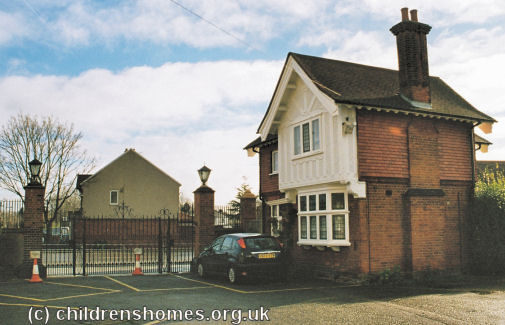
Girls' Village Home entrance lodge and gates, 2005. © Peter Higginbotham
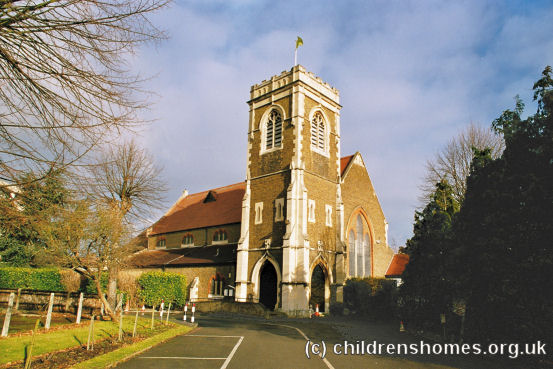
Girls' Village Home church, 2005. © Peter Higginbotham
Records
Note: many repositories impose a closure period of up to 100 years for records identifying individuals. Before travelling a long distance, always check that the records you want to consult will be available.
- Barnardo's 'Making Connections' and Family History Services — for enquiries relating the records of children formerly in the care of Barnardo's and those of other organisations absorbed by them.
Census
Bibliography
- Barnardo, Syrie Louise, and Marchant, James Memoirs of the Late Dr Barnardo (Hodder & Stoughton, 1907)
- Batt, J.H. Dr. Barnardo: The Foster-Father of "Nobody's Children" (S.W. Partridge, 1904)
- Bready, J. Wesley Doctor Barnardo (Allen & Unwin, 1930)
- Higginbotham, Peter Children's Homes: A History of Institutional Care for Britain's Young (2017, Pen & Sword)
- Rose, June For the Sake of the Children: Inside Dr. Barnardo's: 120 years of caring for children (Hodder & Stoughton, 1987)
- Wagner, Gillian Barnardo (Weidenfeld & Nicholson, 1979)
Links
- Barker, Jeff Caring for Other People's Children — Jeff Barker's Memoirs of working at the Canterbury, Barkingside and Bedford Barnardo Homes.
- The Barnardo's website.
- The Goldonian Website — memories and information from former Barnardo's children.
Except where indicated, this page () © Peter Higginbotham. Contents may not be reproduced without permission.


